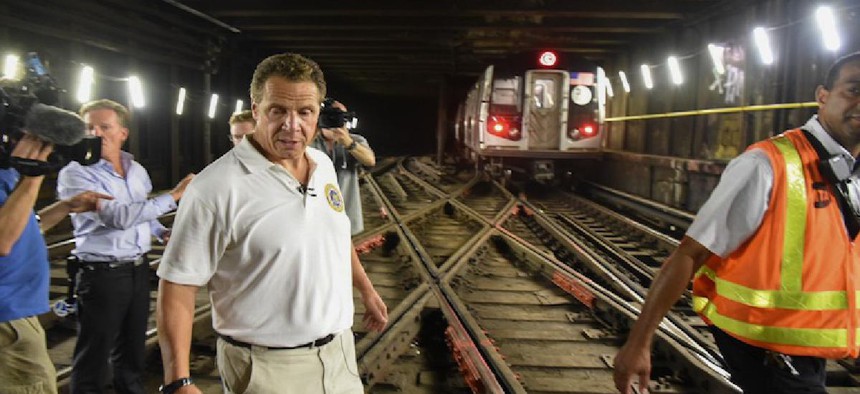Opinion
If New York City pays more for the MTA it should gain more fiscal autonomy

Office of Governor Andrew M. Cuomo
After weeks of charges and countercharges between Mayor Bill de Blasio and Gov. Andrew Cuomo over how much the city and state should each contribute towards financing the Metropolitan Transportation Authority, the mayor seemingly conceded that the city would contribute more, provided the state Legislature approved a tax hike on high-income households.
While the immediate reaction to this proposal from leaders in Albany was lukewarm at best, the fact that the mayor had to look to the Legislature for approval highlights the need for one change that should be part of any agreement by the city to increase its MTA contribution: the city can’t be expected to shoulder more of the cost unless the state grants it greater autonomy when it comes to raising its own revenue.
RELATED: MTA on-time performance has dropped since Cuomo took office
Let me begin with two observations.
First, a regional transportation system funded with a broad set of revenues makes a great deal of sense. New York City and its suburbs both benefit from a robust and well integrated transit system, provided the costs are reasonably distributed and investments reflect the needs of the metropolitan region as a whole rather than favoring one set of users over another. The state’s primary role in managing and arranging funding for the MTA is appropriate, given the region-wide need for a reliable and coordinated public transportation system.
Second, New York City’s residents and businesses already contribute heavily to the MTA’s budget. Most of the dedicated tax revenue collected in the MTA region – the five boroughs plus the seven surrounding suburban counties – comes from city pockets, and subway and bus riders in the city account for over 75 percent of all MTA fare revenue. City taxpayers also help pay for the MTA indirectly, as the city budget provides over $400 million in operating support annually to the MTA, using funds raised through city taxes. (That figure excludes reimbursements to the MTA for running the Paratransit system and several formerly private bus lines in Queens that the city asked the agency to take over.) In 2016, MTA operating support in the city budget included $158 million in required city payments for New York City Transit operations (so-called 18B funding); $90 million for maintenance of LIRR and MetroNorth stations in the Bronx, Brooklyn and Queens; $63 million for operation of the Staten Island Rapid Transit system; and $43 million in mobility tax on the city’s own payroll. The city also spent $228 million for MTA capital projects in 2016 and has pledged a total of $2.5 billion for the 2015-2019 capital plan.
Still, some, including MTA Chairman Joe Lhota, have argued that the city needs to do more to support MTA’s operations and capital investments, even going so far as to argue that, under a 1981 law, the city, rather than the state, is obligated to provide for the upkeep and improvement of subway infrastructure. The call for more from the city has grown as the MTA released a subway Action Plan calling for the city and state to split the $836 million cost of operational and capital improvements intended to stabilize the system as longer-term plans are made.
RELATED: Gateway to the subway, transportatoin officials talk solutions
This call for the city to do more might be more palatable if it were matched with a loosening of the state’s reins on the city’s fiscal power, not to mention granting the city input commensurate with its contribution when the MTA’s capital investment priorities are determined. A larger city contribution would almost certainly require new revenues – which the city currently has little ability to generate on its own.
Recall the fate of two recent congestion pricing proposals that relied on charging vehicles a fee when entering Manhattan’s central business district. The two plans, one from the Bloomberg administration and a more recent one from MoveNY would have raised significant new revenue to fund transportation investments. Because New York City is not allowed to impose the necessary tolls without authorization from Albany, these proposals have gone nowhere.
The story is the same on taxes. Other than setting the overall rate on the property tax, the city has virtually no power to make changes to its existing taxes or adjust tax rates, let alone establish new revenue streams. Because the state holds tightly onto its power over local taxes, the city must look to Albany to enact the city’s tax policy. Changes the city needs, even those that don’t affect upstate lawmakers, frequently wind up as chips in the wheeling and dealing that dominates the state capitol.
The fiscal balance between New York state’s local governments and Albany in terms of taxing power and the division of responsibility for paying for services such as transportation, health care, public assistance and education are decades old. Localities in New York bear much larger shares of the costs of Medicaid and public assistance than in other states. The local share of education is also higher than the average elsewhere. In turn, state taxes in New York are relatively moderate while local taxes are among the highest in the country. Moving one piece of the delicately balanced structure by forcing the city to spend more on public transportation without enhancing its fiscal autonomy could ultimately upset more than just the mayor and the governor.
George Sweeting is the deputy director of the New York City Independent Budget Office.
NEXT STORY: Dan Loeb and the political price of racism